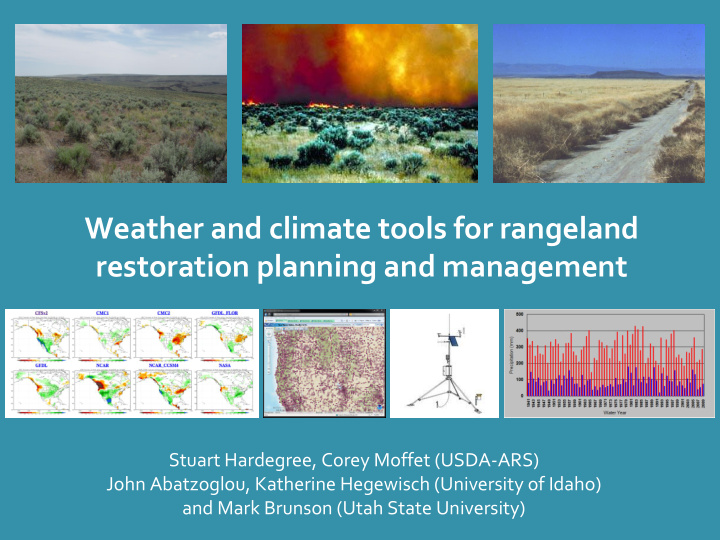



Weather and climate tools for rangeland restoration planning and management Stuart Hardegree, Corey Moffet (USDA-ARS) John Abatzoglou, Katherine Hegewisch (University of Idaho) and Mark Brunson (Utah State University)
Site Availability, Species Availability, Species Performance Limit Nutrients Adapted Plant Materials Planting and Seedbed Preparation Alter Seeding Rate Prescribed Grazing Mulch Prescribed Fire Pre-emergent Herbicide
Site Availability, Species Availability, Species Performance Limit Nutrients Adapted W Plant Materials Planting E and Seedbed A Preparation Alter Seeding Rate T H Prescribed Grazing Mulch E Prescribed Fire Pre-emergent R Herbicide
Seed Germinated seed Emerged seedling Juvenile Adult Established seedling
Rangeland Weather: Arid/Semi-arid, Highly Variable Annual Boise, Idaho March - May
Rangeland Weather: Arid/Semi-arid, Highly Variable Annual Boise, Idaho Shorter time scale: more highly variable March - May
Learning while doing Adaptive iteration
Active Adaptive Management Learn from Doing Option A Unsuccessful Partially Option B Successful Develop Compare Implement Management Outcomes Option C Options Option C Successful Option D Unsuccessful Adapted from: Allen CR, JJ Fontaine, KL Pope and AS Garmestani. 2011. Adaptive management for a turbulent future. Journal of Environmental Management 92:1339-1345
Active Adaptive Management Learn from Doing Option A Unsuccessful W E Partially Option B A Successful Develop Compare Implement Management T Outcomes Option C Options H Option C Successful E R Option D Unsuccessful Adapted from: Allen CR, JJ Fontaine, KL Pope and AS Garmestani. 2011. Adaptive management for a turbulent future. Journal of Environmental Management 92:1339-1345
Weather Centric Adaptive Management Poor Weather Re-Assess Year Option A Unsuccessful Moderate Weather Re-Assess Year Good Weather Abandon Year Poor Weather Consider Year Partially Option B Moderate Weather Consider Successful Year Good Weather Re-assess Year Poor Weather Unlikely Year Option C Successful Moderate Weather Adopt Year Good Weather Consider Year
Iterative/Contingency Adaptive Management Square One Unsuccessful Year 4 Contingency 1 Year 3 Year 4 Contingency 1 Contingency 2 Year 4 Year 2 Contingency ... Year 3 Contingency 2 Contingency 1 Year 3 Contingency ... Partially Year 2 Successful Contingency 2 Year 2 Contingency ...
Management Implications: • Access to weather information where you don’t have a weather station. • Retrospective analysis of field success in terms of seasonal patterns of precipitation, air temperature, and soil conditions. • Expansion of inferences from short term field studies. • Interpretation of field results for adaptive management • Development of long-term, weather-centric contingency plans for rangeland restoration
Questions? GBRMP John Abatzoglou Corey Moffet Alex Boehm Tom Monaco Cynthia Brown Génie MontBlanc Mark Brunson Mike Pellant Jeanne Chambers David Pilliod Matt Germino Bruce Roundy Nancy Glenn Jeanne Schneider Anne Halford Nancy Shaw Katherine Hegewisch Roger Sheley Jeremy James Tony Svejcar Gwendwr Meredith Justin Welty
The preceding presentation was delivered at the 2017 National Native Seed Conference Washington, D.C. February 13-16, 2017 This and additional presentations available at http://nativeseed.info
Recommend
More recommend